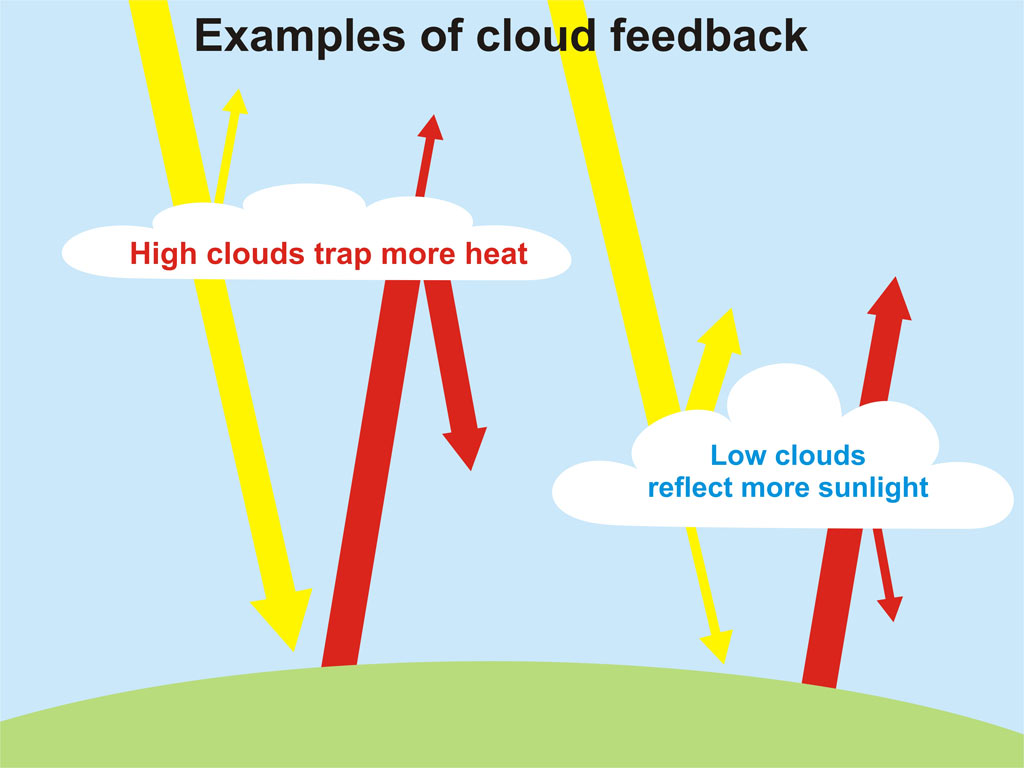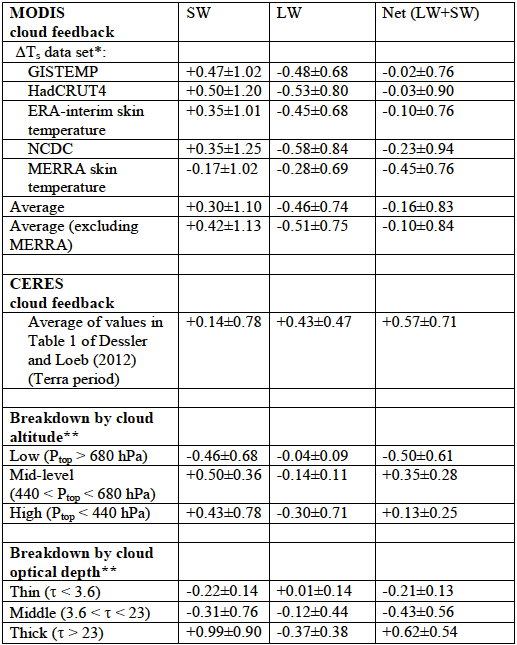
The role of clouds as a climate feedback – whether they amplify or dampen global warming, and by how much – is one of the largest remaining uncertainties in climate science. Climate contrarians will often invoke the cloud feedback, claiming that they will dampen future global warming so much that future climate change will be too small to worry about. Dessler (2010) estimated the short-term cloud feedback using measurements by the Clouds and the Earth’s Radiant Energy System (CERES) instruments on NASA's Terra satellite from March 2000 to February 2010, finding that the net feedback is fairly small, but most likely positive (amplifying global warming).
Two new papers on the subject are now out, An analysis of the short-term cloud feedback using MODIS data by Zhou, Zelinka, Dessler, and Yang, and Impact of dataset choice on calculations of the short-term cloud feedback by Dessler and Loeb. As the titles suggest, Zhou et al. use cloud measurement data from the Moderate Resolution Imaging Spectroradiometer (MODIS), also on NASA’s Terra satellite over the same 2000–2010 timeframe, while Dessler and Leob examine how the use of different clear-sky top-of-atmosphere (TOA) energy flux and surface temperature measurements change the results using the approach in Dessler (2010).
The scientists find that they get slightly different results for the short-term cloud feedback when using MODIS and CERES data. Dessler (2010) found a short-term global cloud feedback of 0.54 ± 0.74 Watts per square meter per Kelvin (W/m2/K) using CERES, while Zhou et al. (2013) estimates the feedback at -0.16 ± 0.83 W/m2/K using MODIS data. The uncertainty ranges overlap, but obviously the most likely value in the former is positive, and in the latter is negative. Dessler and Loeb confirmed that the CERES-based results in Dessler (2010) are robust, differing by just 0.2–0.3 W/m2/K when using different TOA flux measurements, though differing by as much as 0.8 W/m2/K with different temperature datasets.
In either case, the evidence indicates that the short-term cloud feedback is a relatively weak one. Zhou et al. suggest that the result using MODIS data is biased low, which would indicate that the feedback is probably positive, slightly amplifying global warming.
Clouds have two competing effects on global temperatures – they have a cooling effect by reflecting sunlight back into space, and they have a warming influence via the greenhouse effect. Overall the net effect is one of cooling, but when the climate warms, whether this results in more of the cooling or warming cloud influence depends on which types of clouds tend to increase in a warmer world (Figure 1).
Figure 1: Examples of global warming feedback effects by high and low elevation clouds
As Zhou et al. note, the uncertainty as to how clouds will respond to a warming world is one of the largest contributors to the uncertainty in climate sensitivity (the total amount of warming in response to a global energy imbalance, e.g. caused by an increased greenhouse effect, including feedbacks). Over the past several decades, climate scientists have been unable to narrow the possible range of climate sensitivity values, which remains at 2 to 4.5°C global surface warming in response to a doubling of atmospheric CO2.
This is why cloud feedback research is important, to try and narrow that range down so that we can more accurately predict how much global warming to expect in the future. However, since we only have good satellite cloud observations since 2000, scientists can only estimate the short-term cloud feedback, which may be different than the long-term cloud feedback.
Both of the studies discussed here estimate the short-term cloud feedback by calculating the cloud contribution to the change in incoming and outgoing energy at the top of the atmosphere over the past decade, and comparing it to changes in surface temperature over the same timeframe.
As in Dessler (2010), Dessler and Loeb estimate the cloud feedback by taking the difference between the observed incoming and outgoing energy at the top of the atmosphere (TOA flux, or ?Rall-sky), and what it would be if the sky were clear with no cloudcover (?Rclear-sky), and comparing this result (?Rcloud) to the change in global surface temperature.
Dessler and Loeb estimate ?Rclear-sky and ?Rall-sky using various different satellite instruments and methods. They find that ?Rall-sky is consistent between the three CERES instrument datasets they examine, but there is larger variation in the ?Rclear-sky estimates.
Dessler and Loeb also estimate the cloud feedback using a different methodology that does not require a ?Rclear-sky estimate, which they call the "subtraction method" and involves subtracting the contributions to TOA flux due to other non-cloud factors from ?Rall-sky, leaving just ?Rcloud. Using the subtraction method results in a cloud feedback estimate ranging from +0.28 to +0.84 W/m2/K, with a most likely value of 0.61 W/m2/K. This is in very good agreement with the results of Dessler (2010), and most of the other results in Dessler and Loeb (2013), which are summarized in Table 1.
Table 1: Average of the total cloud feedback values in W/m2/K. The Terra period covers March 2000–June 2011, the Aqua period covers July 2002–June 2011. The average ERA and MERRA columns are the average of the feedbacks using those reanalyses for the cloud radiative forcing adjustments.
Using different global surface temperature datasets made a bigger difference in the cloud feedback result (Table 2).
Table 2: Average of the ensemble of total cloud feedbacks calculated using a single
surface temperature data set, in W/m2/K. The feedbacks are calculated over the Aqua period, July 2002–June 2011. The averages are broken into ERA and MERRA, which is the reanalysis that was used for the cloud radiative forcing adjustments.
Overall, Dessler and Loeb conclude that the Dessler (2010) result of a weak but likely positive short-term cloud feedback is robust across the many different datasets.
"These results, when appropriately weighted by a critical evaluation of the relative strengths of the data sets, strongly support the conclusion of D10 of the existence of a likely positive cloud feedback ... Putting everything together, this analysis provides strong evidence supporting D10’s contention that the short-term cloud feedback over the decade of the 2000s was likely positive."
This paper was also intended to investigate the conclusions of Masters (2012), which argued that, using other datasets, one could get a strong negative cloud feedback. Dessler and Loeb (2013) showed that this result was due to problems in the CERES data, and that overall, the short-term cloud feedback value obtained by Dessler (2010) is a robust estimate from the CERES data.
As in the Dessler studies, Zhou et al. examine the cloud contribution to the change in energy flux at the top of the Earth's atmosphere, but in their case they use MODIS data to estimate the change in cloud cover in order to calculate ?Rcloud. The goal of this paper was to test the Dessler (2010) results using a completely independent dataset.
A useful aspect of MODIS is that it allows Zhou et al. to break the cloud feedback down by cloud type, which cannot be done with the CERES data. As with Dessler and Loeb, Zhou et al. examine how their results vary using different surface temperature datasets. The results are summarized in Table 3.
Table 3: Summary of global average cloud feedbacks in W/m2/K, uncertainties are ±2σ

As the fourth column in Table 3 illustrates, all of the most likely cloud feedback results using MODIS data are slightly negative, whereas the Dessler and Loeb results are positive.
Zhou et al. note that their MODIS shortwave radiation estimates (the cooling effect of clouds by reflecting radiation back into space) are in good agreement with the Dessler CERES results; the difference mainly comes from a smaller longwave radiation estimate (increased cloud greenhouse effect) in MODIS as compared to CERES. Zhou et al. note that several issues have been identified with the MODIS data. For example, the satellite has difficulty identifying thin clouds, and it cannot make nighttime observations, both of which would have a larger effect on the longwave radiation measurements. The authors conclude that the cloud feedback estimate based on MODIS data is most likely biased low.
"Putting everything together, it is our judgment that the global-average cloud feedback from CERES is likely to be more reliable than the values obtained from the MODIS measurements. But even with potential global-average biases, the MODIS calculation is useful because it allows us to break the cloud feedback down by cloud type, something that cannot be done with the CERES data."
The Zhou et al. paper ends by emphasizing that they are evaluting the short-term, not long-term cloud feedback.
"That this work is an analysis of the cloud response to short-term climate variations is an important caveat. Previous work has shown little correlation between the cloud feedback in response to these short-term (mainly ENSO) climate variations and the response to long-term global warming (Dessler, 2010; Colman and Power, 2010; Dessler, 2012). Thus, the implications of this for long-term global warming are unclear."
Nevertheless, both of these papers show that the short-term cloud feedback is relatively small, and most likely slightly positive (amplifying global warming). Dessler's group is also looking at other datasets to try to obtain another short-term cloud feedback estimate to help reduce the uncertainty.
Regarding the long-term feedback, for now we will have to be satisfied with the many different lines of evidence that the net overall climate feedback is strongly positive, and climate sensitivity is between 2 and 4.5°C global surface warming in response to a doubling of atmospheric CO2.
Note: these results have been incorporated into the Intermediate rebuttal to the myth 'clouds provide negative feedback'.
Posted by dana1981 on Tuesday, 19 February, 2013
 |
The Skeptical Science website by Skeptical Science is licensed under a Creative Commons Attribution 3.0 Unported License. |